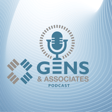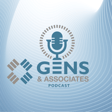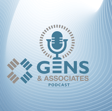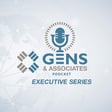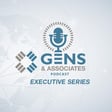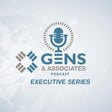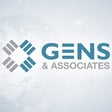Become a Creator today!Start creating today - Share your story with the world!
Start for free
00:00:00
00:00:01

Executive Series Episode #8 - Marc Gabriel (Veeva)
In today's episode, Host Steve Gens is joined by Marc Gabriel (VP, Vault Regulatory at Veeva) to discuss Veeva’s growth in the regulatory space, customer benefit realization, AI and advanced technology, and what’s next for their regulatory practice.
Transcript
Introduction to the Podcast and Guest
00:00:00
Speaker
Welcome to the Gens & Associates Regulatory Executive Podcast. I'm your host, Steve Gens, managing partner of Gens & Associates. In this episode, I'm excited to be talking with Mark Gabriel from Viva. So welcome, Mark. I've been looking forward to this conversation for a long time. I remember the very early days of Viva probably going back to a decade, you know, when you guys were just getting started and it's just ah an amazing story. And I know you've been a big part of that ah journey in regulatory. So before we get started, could you give a brief introduction of yourselves and Viva for our listeners? Yeah, thanks, Steve, for the opportunity. It was really a great idea to have these chats with leaders in the RIM software space. So let me start with a little bit about Viva. We provide cloud software, data, and business consulting for the life sciences industry. ah We're a global company. We're headquartered in the San Francisco Bay Area, and we have about 7,000 employees right now.
00:00:57
Speaker
We offer solutions in the R and&D and commercial spaces. In R and&D, our offerings span clinical, regulatory, safety, and quality of manufacturing. I'm the head of the Vault Regulatory Business Unit, so I'm accountable for the product's success with a focus on product strategy and market uptake. Our flagship product, Vault RIM, is the leading unified regulatory end-to-end solution for sponsors in life sciences. Okay, so a little bit of background on me. I have a degree in computer engineering.
00:01:26
Speaker
I worked in a business-facing role in IT t at Merck MSC at the beginning of my career. Then I transitioned to consulting first in the system integration space, and then in management consulting. My first RegOps project was while I was at Accenture in 2002, and I've been mostly focused on RegOps ever since. I caught the vault rim bug, if you could say it that way, in 2016. I distinctly remember finally getting it.
00:01:51
Speaker
ah while consulting for a customer. I saw that promise event and it really became really clear to me. And then I joined a year later at Viva in 2017 and I've been in my current leadership role for about two and a half years. Okay, thanks Mark for that background and 7,000 employees. I just go back and you know the story so it's more for our listeners when you know that there was the first ah EU conference and they asked me to be the ah keynote and And they're like, we're hoping, you know, we promised leadership about 40, 60. And this is before you you were like really selling, selling the software and the adoption, then also 120 people you know kind of showed up. And then even coming up to your conference next month. um it's It's just, you know, amazing, but I didn't realize you were already up to 7000 employees. That's, that that's crazy.
00:02:43
Speaker
Yeah, so um maybe a nice place to start and and at a high level is because, you know, the first time I got introduced, it was through Jen when she came over from IBM to Viva. It was more around the, you know, content side looking at ETMF. But but why did Viva enter the rim market?
Evolution of Regulatory Operations Technology
00:03:04
Speaker
And I mean, really quickly, and I think what our listeners would be really interested is the current product strategy, maybe some highlights of that.
00:03:13
Speaker
Yeah, so to help understand our direction, it really is helpful to understand a context some context of the past. um So if you think back to the 1990s, systems helped generate paper in RegOps, right? So paper was the authoritative source, paper submissions were sent to the FDA in truckloads. Many of us remember WordPerfect and PCs and generating that paper that became authoritative. ah Where I was at Merck, we had this quaint concept of interoffice mail. I don't know if you remember that, Steve.
00:03:41
Speaker
but manuscripts were shuffled between sites for manual review and approval. right ah Then in the late 1990s, we had the finalization of 21 CFR Part 11 by the FDA, and that was a watershed moment because for the first time, the electronic format could be the authoritative source. um Paper could be removed from the equation mostly, at least for major markets. As a result of that, in the early 2000s, we saw a wave of innovation being released into the marketplace, right? Document management solutions,
00:04:11
Speaker
tracking, publishing, imaging systems, all sorts of systems from all sorts of vendors that that we know today. um And those big investment by sponsors turned into big productivity improvements. So we saw days and weeks shaved off of timelines, right? That paper no longer needed to be circulated. It could be sent electronically and maintained fully electronically. And that return on investment was significant. Then came the innovation challenge. Technology was siloed, right? Each one of these solutions were siloed, but the and end process was far more integrated. So IT needed to stitch the systems together to support that end-end process. So so lots of SI work. Then the 2010s rolled
Viva's Product Evolution and Business Transformation
00:04:50
Speaker
around. All those productivity improvements had been banked, but IT t was still left with a maintenance headache. Lots of upgrades, lots of messy and costly integrations, but really not yielding all that much in terms of new improvements. But yet the business was changing. So in the 2010s, we really saw an uptick of things like M and&A,
00:05:09
Speaker
new business sourcing models, outsourcing, new health authority requirements that significantly increase and a lot more change. And IT t really struggled to keep up with those with limited means. We released our first app in 2013 that was Vault Submissions, our content management offering. So something that mirrored the siloed app marketplace that existed at the time with a notable improvement that it was cloud-based. And we stayed close to our customers. We continued listening to our customers,
00:05:36
Speaker
And they helped us recognize the power potential of full end-to-end revenue. In 2017, we announced thought submissions, archiving, and development registrations. And then we reoriented our vision, which became enabling business transformation for regulatory. When we can support the end-to-end process, we can focus on the business process, not just the features. And with the most important components under one roof, we can evolve and optimize them to meet the needs of a rapidly changing regulatory world.
00:06:06
Speaker
Right? Change becomes business as usual. And then the customer's IT organization can switch their focus from maintaining that infrastructure to deploying those new capabilities. Yeah, thanks for that ah history, and i'm I'm taking some notes here, and you just reminded me when I was back in industry, and Johnson & Johnson, actually, Janssen and the pharmaceutical sector, and my last rotation was from the commercial side ah to the Janssen Research Foundation, and the regulatory folks were doing something called a candida, you know, yeah and having those big docutex and all that. And although I was, my chore was to digitize the the t the ETMF,
00:06:44
Speaker
That was amazing thing and kind of fast-forward to because I know what some of your customers that you know kind of mutual clients and all that like back in my chance and days the big project was last patient visit to database lock um And that used to take us six months, but then and this is paper CRS, right got it down to three weeks but now this this could be days or or maybe hours and I know some mutual ah customers, when we think about database lock to the actual submission, that tends to be a 14, 16-week process you know to the CSR, the actual submission to the health authority. They're looking at like taking another leap to 50% less. So the IT systems, the processes, roles, you know with this next big push, it all has to change.
00:07:33
Speaker
so So maybe that's where the one thing that I get very curious about, and we're in such a unique position here against and associates with our research and especially the big, you know, regulatory ah study we do every two years, the world class rim. And, you know, we've watched your market share just grow substantially. It's very impressive. But we get more focused on the customer satisfaction rating and our innovation index.
00:08:00
Speaker
And with such growth comes you know wonderful things, but also challenges.
Growth Management and Customer Satisfaction at Viva
00:08:04
Speaker
So um cycle after cycle after cycle, 2016 to 18, 2022, and now in 2024, you guys you know have strong customer satisfaction. You're always at the at the top end or at the top on the innovation index. So it's more a question about organization and how do you and your other peers and leadership It's kind of managing the growth so that, you know, existing and new customers get the best of Viva. So what's what's kind of the secret sauce there organizationally in such a high period of growth? Yeah, Steve, a couple of things come to mind. The first is at Viva, we have this concept of autonomy over alignment. So if something is best for one business unit, you know, we can deviate from that company standard. So that allows us to maintain some agility as we continue to grow.
00:08:55
Speaker
um The second thing that comes to mind is we really put a lot of effort into staying close to our customers. um From our two customer summits per year, our community meetings, Viva Connect, working group meetings, onsite project meetings, governance and so forth. We have hundreds of these customer facing meetings every year and we keep them to make sure that we ensure, we feel the pulse of the business community on a regular basis, right? And and we staff a coordinator to make sure that we can maintain those connections.
00:09:24
Speaker
That being said, we are very conscious of the the innovator's dilemma, which posits that we should be listening to our smallest customers as well as our largest ones. The temptation is is always to focus on just the top 20. They're the biggest and very often they're the most vocal. We have over 400 ballroom customers. So by definition, most of our customers are not in the top 20. The smaller customers are a photo ground for a lot of inspiration and many of our top 20 customers even recognize that as well.
00:09:53
Speaker
and listen carefully to the ideas coming from the small end of the market. So that's a key thing that we think about on a fairly regular basis. um Also, we haven't changed our pace. It's still three releases a year. We're just releasing more features and enhancements per year than we have in the past. Our product team is about four times larger than it was just five years ago. So we've we've grown as the needs have evolved and as the number of customers have evolved. And with that,
00:10:23
Speaker
rapid change and large number of features per release, right? There's a human challenge that we think about as well. The external environment is changing rapidly and we're responding with rapid product evolution. And that's challenging for many customers. There's a lot of change in the world that we can't control. So there's always that temptation to pump the brakes on the things that we can control. So we think deeply about whether or not features should be auto on behind a flag or configurable.
00:10:50
Speaker
Each one has its pros and cons, but every time we don't auto on a feature, we delay value to that customer. The flip side, of course, is that we impose change on that customer. Because we put that burden on them to do something before the end user can start benefiting, that at that risks some delay. I mean, in the end, really the best thing we can do is just continue to stay close to our customers and listen. We won't get it exactly right each time, but Viva has a culture of continuous improvement. And occasionally when we get it wrong, no we we say so.
00:11:21
Speaker
Both ideas that don't come out are just an opportunity to learn course, correct? Yeah, again, I'm ah rapidly taking notes and it occurred to me like 3 or 4 years ago. um Because we're really big and with our world classroom methodology and it's really nothing about regulatory. It's it's good management practices and.
00:11:40
Speaker
you know It's very clear that you know every organization has large changes every five, six, seven years, but it's that continuous improvement, you know a metric driven or data driven continuous improvement. That's where our top performers, 100% of our top performers. And it occurred to me like you know three or four, maybe five years ago. so Well, that's that's the Viva model because we're three releases a year and I think some,
00:12:06
Speaker
of your ah customers probably struggle with that because they underestimate the organizational impact. It's not like the old days, we have the episodic change, big analysis, you know, go live hypercare, then we're kind of quiet for, you know, two or three years until the next release that going with Viva is continuous improvement. And you have to adjust the organization like I know, some of our mutual clients and it tends to be the larger ones that maybe have committed not only in regulatory, but maybe quality and and clinical, they have center of excellence, you know, just to manage the, you know, kind of three releases a year. and And the other point that you bring up, we're really big because we do change management and other things, you know, with our clients, besides, you know, the things we're really well known for on the strategy side, but
00:12:56
Speaker
We always talk about feedback loops. And from a provider standpoint, it's those touch points. And even in the early days of the Viva Summit, I always enjoyed that it's you always made it about the customer you know and have them present and then have you know some of your briefings, your customer account ah counsels with that. so it's I think with the three times a year and those things, you're getting constant feedback on, hey, how can we improve the platform you know for everybody? So you know tip my hat to Viva for that. Now, the the next question I have for you.
00:13:34
Speaker
And it's a loaded one because you know the conversation on
AI and Advanced Technologies in RIM Processes
00:13:38
Speaker
AI, it's, you know and you've heard me kind of speak that it's it's hyped. you know I really liked the hype cycle from Gartner. And the conversation is so hyped and we did a deeper dive on our research where the world-class rim and lots of companies, although there's a lot of experimentation, there's you know very little in production yet.
00:13:59
Speaker
You know, we believe in the promise of generative AI is probably going to take ah you know a bit longer than what people would hope for things like the CSR, but it's like a writing assistant or a virtual assistant that's not replacing. But there's a lot of baskets of this advanced technology. So the ones I've already mentioned, that's throw in RPA, structure content management.
00:14:21
Speaker
So, how's Viva viewing, because you have the balance of having the transactional system that just supports all the regulatory activities activities day in, day out, and more of these advanced technologies, you know, that can help automate and do other things. So, how's Viva viewing AI and some of these other advanced technology in the near term, and I think more importantly,
00:14:46
Speaker
in the longer term. you know So what what what should customers and prospective customers expect out of Viva? Yeah, so to start, we know there's a lot of enthusiasm about about AI. So we've put quite a bit of thought into how we can provide the best value. So our AI strategy has two parts. The first part is what we do ourselves, what we build into the product. And the second part is enabling partners. So let's start with the product. We've always been business process focused.
00:15:14
Speaker
We don't build bells and whistles without understanding how they fit into the business process. So we incorporate AI where it enhances the RIM process specifically. So an example here is health authority correspondence questions. We're rolling out functionality to dramatically reduce the number of clicks required to ingest these questions. And we're doing so in multiple stages. We already have a good amount of functionality that exists today and and there's more to come over time. So the second part, as I mentioned, is partnerships and that has two parts.
00:15:42
Speaker
The first part is our direct data API product, which allows data to be extracted much more quickly and frequently than our traditional API. And that data can be stored in a data lake, their warehouse, anywhere that a customer would like. And then we have our partnership program where we work with third parties to certify the solutions they provide to complement the Vault Platform. So we already have about a half dozen AI partners approved with with more to come.
00:16:09
Speaker
So we have our own solutions coupled with partner solutions. We believe choice is really important. So partners remain a key element of our strategy. um One note about data quality and AI, right? So AI won't produce good results without good data. Otherwise it's garbage in garbage out. So our continuous improvement of the product to enhance data quality is just as important as the AI innovation um that takes advantage of that data. So there's a lot of focus on data quality in the current route.
00:16:38
Speaker
So now regarding traditional structured content authoring, we made a decision several years ago to work with partners to bring this functionality to our customers. We generally don't get involved in authoring our applications. It was a strategic decision to remain focused on our core mission. And I think our customers appreciate that focus. and our customer folk At our customer I should say we have several partners who regularly exhibit their solutions in this space.
00:17:03
Speaker
So regarding RPA, so RPA isn't a distinct feature or system in our ecosystem. It's really embedded in our products. So every vehicle vault has workflow tools, allowing our customers and professional services teams to develop company specific process workflows to suit their unique circumstances. Since we cover a rim end to end, those processes can take place entirely within the system.
00:17:26
Speaker
We also have productized wizards to reduce repetitive tasks and those automations will get a lot of attention for us over the next few releases. ah Specifically, we're targeting a series of improvements that will materially reduce the number of clicks to manage registration data. So RPA is definitely an important area and we continue to invest in that space. And in general, we stay really focused by keeping the end in mind. What does the health authority actually require and how can we help produce that in the most efficient way while maintaining quality?
00:17:57
Speaker
It's so easy to get lost in the intermediary deliverables and the entities and theories and get focused on ah too many raw technologies. You really stay focused with you know keeping the end in mind and focus.
00:18:10
Speaker
Yeah, I completely agree, on Mark, and and certainly kind of how you you talked about you know the business process. It's so important to have a business process orientation. you know That's something you know we preach to our clients and I know over the years you and I have talked about like one of the big ones, you know, change control where it's, you know, there's that, you know, connect connection or what we call it connection with the QMS, you know, so the QMS vault. And I know a lot of your clients that have, you know, the regulatory vaults, you know, they they tend to also have the R and&D or both sides of the QMS.
00:18:48
Speaker
So yeah, thanks for that update. So the last question I have is more of a
Excitement about Viva's Future
00:18:52
Speaker
general. So you've been at Viva six or seven years, the last few in a leadership position, but Viva has really transitioned from such a small growing software provider that there was a lot of excitement to where it is today, just just a major, major player you know in the the life science ah ah life sciences sector.
00:19:12
Speaker
So for you, what what excites you most about Viva over the next several years, just either generally or in the in the regulatory area? Yeah, so first at a company level, at over 7,000 people, we still largely operate and innovate in the same way that we did when I joined seven years ago, at whom we had 2,000 employees, right? We call that still Viva. That's a core part of our company culture, and it's a key enabler for growing the business moving forward. So I'm excited about that because it's a great environment to work in.
00:19:43
Speaker
um Second thing is that at about rim level, we continue to evolve the product to further reduce cycle times and improve efficiencies. The active dossier feature is going to be significantly approved over the next several releases and coupled with global content plans will help our customers enable fast product launches in more markets simultaneously. Traditional technology has been a headwind to getting to the rest of the world approvals you know in a timely manner. We want to turn that headwind into a tailwind. So that's going to be a big focus.
00:20:12
Speaker
And then automation will also continue to be a major focus as well. There's always room for improvement, especially when you have a unified end-to-end environment like Vault Rim. As I mentioned earlier, we're putting a lot of focus on the wizards to further automate registration management, but that's not the only area. All aspects of end-to-end room are going to see automation improvements over the next couple of releases. And publishing also is a very exciting area for us. Every morning I wake up, I look at the stats reflecting the total number of submissions published by our customers and really pleasantly surprised by the uptake. It took us a while to get some momentum in that space. People were skeptical about the concept of continuous publishing. It's a big change in mindset and process. And as mentioned earlier, change hesitancy has been a break on progress. I remember about a decade ago, Accenture discontinued support for BlackBerry devices. And I was really upset because I liked that physical keyboard and I didn't want an iPhone. And to me, this was a big unwelcome change. I didn't ask for it.
00:21:10
Speaker
Now, can you imagine today using a mobile device with the bottom third rigidly dedicated to a keyboard? The old way of doing things impeded innovation. It's hard to see that at the time, right? Continuous publishing is similar. The old approaches were too rigid and limited our ability to reduce cycle times. People are now seeing that we have five customers in the top 20 now in production and publishing, and we're seeing increased in interest in momentum over time.
00:21:36
Speaker
And we're also very lucky to be in a very well capitalized organization. So we have the financial ability to buy or build the new capabilities, but we force ourselves to be very disciplined in this space. Acquisitions are tempting, but they're hard to get right. And they can easily distract from the core mission, if not well executed. Building new capabilities are essential to our growth, but we pace ourselves. There's a right time and a right way to do it. Roll it out too early and it doesn't get used, but we don't want to be too late either.
00:22:04
Speaker
So these are ongoing discussions internally here at Viva. So Mark, I must say, I miss my Blackberry, you know, I remember those days.
Reflection on Viva's Impact in Life Sciences
00:22:14
Speaker
And, but yeah, it evolved. So like, if we look back and you know what I have, and I finally have an iPhone, I was I was on the you know, another company, a competitor of of the iPhone for I don't know, you know, maybe, maybe eight or nine years until I was forced by my family, because it was messed up with the text, the pictures, and I finally went over to the iPhone and and just really love it. But ah you know, it's, it's the point that you were making.
00:22:42
Speaker
that ah Blackberry is probably an NBA course thing, how they missed the boat on the next wave of innovation to really the smartphone. And it goes back to the brilliance of Steve Jobs about envisioning something before people realize they need it. So certainly, you know, Viva has been such a major contributor to the space yeah know back in. It wasn't just about being in the cloud. It's a lot more as you guys were building we were starting and really pushing the end-to-end room thinking because it's about simplification you know consolidation in any kind of business environment if you have too much complexity it's like where where can we reduce that and i really love the comment you know coming from two to seven thousand people is very significant kind of with the mantra of still
00:23:29
Speaker
you know, still Viva. So thanks again, you know, for the time, you know, the the major contribution Viva and yourself continues to make to this space. I'm sure some of our listeners, most people know Viva, um but if they don't and want to, you know, kind of contact with you or the team, you know, what's the best way to do that? Should they be going through the that the website, LinkedIn? What would you suggest, Mark? Yeah, absolutely. Through the website, they can connect with me via LinkedIn either way works or if they know any Viva ah just connect with that Veevan and they'll connect them to me as well.
00:24:02
Speaker
Okay, that sounds good. And for our listeners, if you have any questions, you know, for myself or anybody on the Gensin Associates team, I think the same thing if you go to our website on contact us or we're on LinkedIn all the time, just reach out. So again, Mark, thanks very much for a great discussion and best wishes for you and Viva as you march forward and I'll be seeing you next month in Boston.
00:24:31
Speaker
Great. Thank you, Steve.
